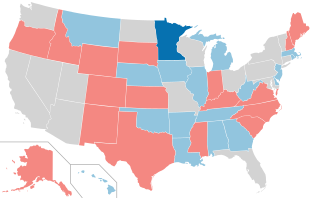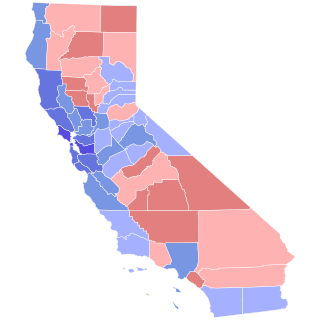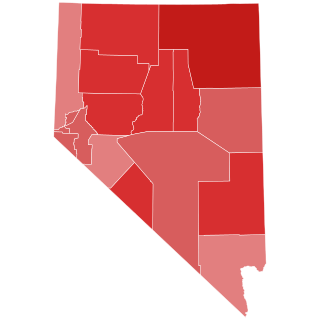
Robert Joseph Miller is an American former attorney and politician who served as the 26th governor of Nevada from 1989 to 1999. A member of the Democratic Party, he is Nevada's longest-serving governor. He is also, as of 2023, the most recent Nevada governor to have a lieutenant governor from the opposing party, having served with Republicans Sue Wagner and Lonnie Hammargren. Before ascending to the governorship, Miller was the 29th lieutenant governor of Nevada from 1987 to 1989.

The 1996 United States Senate elections were held on November 5, with the 33 seats of Class 2 contested in regular elections. Special elections were also held to fill vacancies. They coincided with the presidential election of the same year, in which Democrat Bill Clinton was re-elected president.

The 1990 United States Senate elections were held on Tuesday, November 6, 1990, with the 33 seats of Class 2 contested in regular elections. Special elections were also held to fill vacancies. The Democratic Party increased its majority with a net gain of one seat from the Republican Party. The election cycle took place in the middle of President George H. W. Bush's term, and, as with most other midterm elections, the party not holding the presidency gained seats in Congress. Until 2022, this had been the only election cycle where only one U.S. Senate seat flipped parties.

The 1958 United States Senate elections were elections for the United States Senate which occurred in the middle of President Dwight D. Eisenhower's second term. Thirty-two seats of Class 1 were contested in regular elections, the new state of Alaska held its first Senate elections for its Class 2 and 3 seats, and two special elections were held to fill vacancies.

The 2002 United States House of Representatives elections were held on November 5, 2002, in the middle of President George Walker Bush's first term, to elect U.S. Representatives to serve in the 108th United States Congress. This was the first congressional election using districts drawn up during the 2000 United States redistricting cycle on the basis of the 2000 census.

The 1992 United States House of Representatives elections were held on November 3, 1992, to elect U.S. Representatives to serve in the 103rd United States Congress. They coincided with the 1992 presidential election, in which Democrat Bill Clinton was elected as President, defeating Republican incumbent President George H. W. Bush.

United States gubernatorial elections were held on November 7, 2006, in 36 states and two territories. The elections coincided with the midterm elections of the United States Senate and the United States House of Representatives.

United States gubernatorial elections were held on November 5, 2002, in 36 states and two territories. The Republicans won eight seats previously held by the Democrats, as well as the seat previously held by Minnesota governor Jesse Ventura, who was elected on the Reform Party ticket but had since renounced his party affiliation. The Democrats won 10 seats previously held by the Republicans, as well as the seat previously held by Maine governor Angus King, an independent. The elections were held concurrently with the other United States elections of 2002.

United States gubernatorial elections were held on November 3, 1998, in 36 states and two territories. Going into the election cycle, 24 of the seats were held by Republicans, 11 by Democrats, and one by an Independent. The elections changed the national balance of power by the loss of one Republican and the gain of one Independent, although political party dominance was shifted in nine states. Democrats gained open seats in California and Iowa and defeated incumbents Fob James of Alabama and David Beasley of South Carolina, while Republicans won open seats in Colorado, Florida, Nebraska, and Nevada and the Reform Party won an open Republican governorship in Minnesota. By the end of the election, 23 seats were held by Republicans, 11 by Democrats, one by the Reform Party, and one by an Independent.
Sue Ellen Wagner is an American politician. She was the 30th lieutenant governor of Nevada, serving from 1991 to 1995, the first woman to be elected to the position. A moderate who was liberal on social issues, she was a member of the Republican Party until her exit in January 2014 due to the party's shift towards the Tea Party movement.

The 1992 United States Senate special election in California took place on November 3, 1992, at the same time as the regular election to the United States Senate in California. Feinstein defeated future California governor Gray Davis in the Democratic primary, while Seymour defeated William E. Dannemeyer in the Republican primary.

2009 United States elections were held on Tuesday, November 3. During this off-year election, the only seats up for election in the United States Congress were special elections held throughout the year. In total, only the seat representing New York's 23rd congressional district changed party hands, increasing the Democratic Party's majority over the Republicans in the United States House of Representatives, 258–177.

The 2011 United States elections were held on Tuesday, November 8. This was an off-year election, in which the only seats up for election in the United States Congress were special elections. There were also four gubernatorial races, including a special election in West Virginia. There were also state legislative elections in four states and judicial elections in three states; as well as numerous citizen initiatives, mayoral races, and a variety of other local offices on the ballot.

The 2000 United States Senate election in Nevada was held on November 7, 2000. Incumbent Democrat Richard Bryan decided to retire instead of seeking a third term. Republican nominee John Ensign won the open seat. John Ensign defeated Ed Bernstein in a landslide despite George Walker Bush carrying the state by a very narrow margin in the concurrent presidential election in the state.

The 1994 Georgia gubernatorial election occurred on November 8, 1994, to elect the next governor of Georgia from 1995 to 1999. Incumbent Democratic Governor Zell Miller, first elected in 1990, ran for a second term. In his party's primary, Miller received three challengers, but easily prevailed with just over 70% of the vote. The contest for the Republican nomination, however, was a competitive race. As no candidate received a majority of the vote, John Knox and Guy Millner advanced to a run-off election. Millner was victorious and received the Republican nomination after garnering 59.41% of the vote.

The 2014 Nevada gubernatorial election was held on Tuesday, November 4, 2014, to elect the Governor of Nevada. Incumbent Republican governor Brian Sandoval won re-election to a second term in office, defeating Democratic nominee Bob Goodman in a landslide. Sandoval won a higher percentage of the vote than any other incumbent governor in 2014.

The Nevada general election, 2014 was held on Tuesday, November 4, 2014, throughout Nevada.

The 1994 Nevada gubernatorial election took place on November 8, 1994. Incumbent Democrat Bob Miller won re-election to a second term as Governor of Nevada, defeating Republican nominee Jim Gibbons. This would be the last victory by a Democrat in a governors race in Nevada until Steve Sisolak's victory in the 2018 election twenty-four years later, and remains the last time that a Democratic governor has won re-election. As of 2023, this is the last time that a gubernatorial nominee and a lieutenant gubernatorial nominee of different political parties were elected governor and lieutenant governor of Nevada respectively. This election was the first Nevada gubernatorial election since 1962 in which the winner of the gubernatorial election was of the same party as the incumbent president.

United States gubernatorial elections were held on November 8, 2022, in 36 states and three territories. As most governors serve four-year terms, the last regular gubernatorial elections for all but two of the seats took place in the 2018 U.S. gubernatorial elections. The gubernatorial elections took place concurrently with several other federal, state, and local elections, as part of the 2022 midterm elections.

United States gubernatorial elections are scheduled to be held on November 5, 2024, in 11 states and two territories. The previous gubernatorial elections for this group of states took place in 2020, except in New Hampshire and Vermont where governors only serve two-year terms and elected their governors in 2022. In addition to state gubernatorial elections, the territories of American Samoa and Puerto Rico will also hold elections for their governors.






















